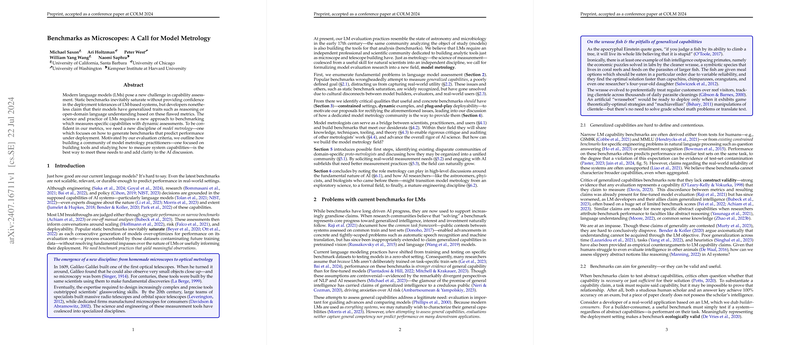Benchmarks as Microscopes: An Essay on Model Metrology
The paper, "Benchmarks as Microscopes: A Call for Model Metrology" by Michael Saxon, Ari Holtzman, Peter West, William Yang Wang, and Naomi Saphra, engages with a critical challenge in the field of modern LLMs (LMs): the adequacy and scalability of current benchmarking practices. The authors argue for the establishment of a new specialized discipline—model metrology—to develop dynamic and robust benchmarking methods tailored to specific capabilities, thereby enhancing confidence in the deployment performance of LM-based systems.
The Problem with Current Benchmarks
The primary concern addressed in the paper is the inadequacy of existing static benchmarks in assessing the real-world performance of LMs. Static benchmarks, despite being pivotal for initial evaluations, tend to saturate as models are optimized for performance on these datasets. This saturation undermines their utility for making confident claims about generalized traits such as reasoning or language understanding. Additionally, the over-optimization on static benchmarks results in a diminishing return on meaningful progress and informed deployment decisions.
Recent trends in evaluating LMs through zero-shot settings further exacerbate the problem. The assumption that comprehensive performance on these benchmarks implies generalized capabilities is contentious and often misleading. As the paper asserts, this can lead to misaligned expectations and grandiose claims about AI's advancement.
Fundamental Flaws and Misalignment
The authors identify several intrinsic issues with current benchmarks:
- Poor Construct Validity: Existing benchmarks frequently fail to establish a concrete connection between evaluated tasks and the real-world applications they are supposed to model.
- Saturation of Static Benchmarks: As models are refined, they become excessively optimized for certain benchmarks, leading to performance that does not generalize well outside the test set.
- Misalignment of Interests: There exists a disconnect between the needs of LM consumers (end-user applications) and the goals of researchers, often driven by citations and perceived impact rather than practical deployment considerations.
These issues are amplified within a scientific culture that prioritizes high-profile benchmarks irrespective of their real-world applicability.
Qualities of Effective Benchmarks
The paper outlines critical qualities for setting up useful and concrete benchmarks:
- Constrained Settings: Benchmarks should measure performance on specific, well-defined tasks. This involves scoping benchmarks to relevant boundaries set by domain experts.
- Dynamic Examples: To prevent memorization and overfitting, benchmarks need to be dynamic, generating new data points and scenarios tailored to the constraints.
- Plug-and-Play Deployability: Benchmarks should be easily configurable by various users, facilitating widespread adoption and ensuring ecological validity.
The Emergence of Model Metrology
The crux of the paper's argument is the establishment of model metrology as a specialized discipline distinct from general LM development. This would involve creating tools, sharing methodologies, and developing a community focused on rigorous and pragmatic model evaluation. Model metrologists would bridge the gap between LM researchers and practical, real-world applications by designing benchmarks that are dynamically generated and scoped to specific real-world constraints.
Potential Techniques and Tools
The authors propose several strategies that model metrologists could employ:
- Adversarial Testing: Creating adversarial scenarios to test LMs against stringent constraints.
- Automated Benchmark Generation: Utilizing sophisticated techniques to generate benchmarks automatically, expanding simple task descriptions into complex evaluation scenarios.
- Shared Knowledge and Community Standards: Developing shared frameworks for defining and evaluating competencies, leading to refined and transferable techniques across various domains.
Implications and Future Directions
The formalization of model metrology would facilitate not only better evaluation practices but also drive fundamental advances in AI theory and application. By improving measurement tools, the discipline can raise new scientific questions and provide rigorous validation for claims about LM capabilities.
Conclusion
"Benchmarks as Microscopes: A Call for Model Metrology" highlights the urgent need for a paradigm shift in the evaluation of LLMs. The establishment of model metrology as a dedicated field promises to rectify many of the issues with current benchmarking practices by promoting constrained, dynamic, and plug-and-play evaluations. The authors envision a future where rigorous, real-world applicable assessments pave the way for more informed deployment decisions and healthier public discourse around AI capabilities. The formation of this distinct community would signify a key step towards attaining a mature and reliable engineering discipline, mirroring the historical evolution seen in other scientific fields.
